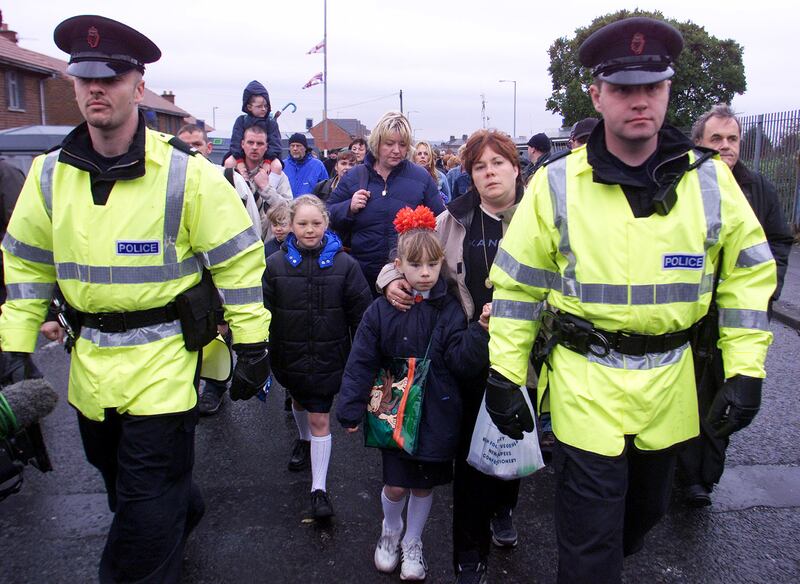A suggestion by Northern secretary John Reid in 2001 that president Mary McAleese meet loyalists protesters who had blockaded a Catholic primary school in north Belfast was immediately dismissed by the minister for foreign affairs Brian Cowen.
The Holy Cross school for girls had been besieged for many months by loyalist protesters, with pupils unable to attend school safely. Intimidation of pupils, parents and staff was occurring on a daily basis.
Confidential records from the Department of Foreign Affairs which have been declassified in Dublin disclose that Reid was of the view that McAleese should meet loyalists protesters during a visit to north Belfast. In an account of a meeting between Reid and Cowen: “While it was entirely a matter for the President as to what she chose to do, Dr Reid suggested it might be wise if she was to signal a willingness to also meet the Glenbryn residents (even if they chose not to take up the offer).”
The Glenbryn estate was predominantly loyalist and often mobs from the area turned up at the school. Nationalists believed that any concession given to the Glenbryn residents would reward their obstructive and intimidating behaviour.
RM Block
Cowen did no more than “note the point, and clarified to Reid it was the Holy Cross Monastery – rather than the school itself – which the President would be visiting”.
The issue was never pursued beyond the suggestion.
In a separate record taoiseach Bertie Ahern commented that the riots and disturbances around the school were a sign of a “deeper malaise” in Northern Ireland.
Teachers at the school received death threats from the paramilitary group the Red Hand Defenders around that time. A memo written by Department of Foreign Affairs official Ray Bassett noted the “strain was now beginning to show on the teachers”.
He said a teacher had told him the events a few days beforehand had been particularly frightening. “Teachers had just managed to close the gates before the loyalist mob descended on the school and PSNI officers present had to draw their weapons to force them away from the school gates,” wrote Mr Bassett.

President McAleese did end up meeting the families during her visit in November 2001, but not the protesters, who she called on to end the rioting.
The visit was later described by Eoin Ó Broin, then a Sinn Féin councillor, now a TD for Dublin Mid West, as a “big morale boost” for the parents and children. “High profile visits showed the Glenbryn residents that their protest was invalid,” he was reported to have said.
Meanwhile the commitment among more hardline loyalists to the peace process continued to be ambivalent before and after the Belfast Agreement was signed. The Ulster Unionist Party MP John Taylor warned in February 1998 of a “civil war” if there was not progress in the talks. He told an Irish embassy diplomat at a meeting in London that he and UUP leader David Trimble had visited the Maze to discuss the peace process with loyalist prisoners, or the “men with tattooed shoulders”. He claimed that during the visit some of the loyalists said they would “leave no nationalist alive in Northern Ireland” and “mount attacks in Dublin”.
Following the Belfast Agreement referendums were held in both jurisdictions on the accord. Amid much concern that unionists would reject the agreement, Northern secretary Mo Mowlam was worried that a visit by US president Bill Clinton during the campaign could damage the prospects of unionists supporting the vote.
Mowlam was reluctant to allow any politician with an international profile to become involved. She told Irish ambassador to the UK Ted Barrington that “she had to consider feelings within Northern Ireland about outside interference”.
She confided to Barrington that President Clinton would be “difficult to keep out”. If he did insist on coming, she said, there would be a need to “keep him off the streets” and confine his visits to “community groups, factories and things like that”. Mr Barrington offered no response to her comments.
In the event Clinton decided not to travel, not because of Mowlam’s opposition but because of Trimble, who was not enthusiastic about the impact that the visit would have on the referendum. In the event the referendum was passed by unionists by the narrowest of margins.
(National Archive files: 2022/45/423, 2022/45/435, 2022/45/58, 2022/45/96, 2022/45/422, 2022/45/423)

















